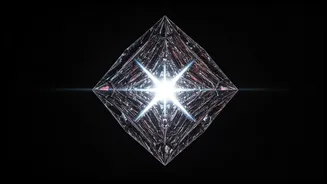What are Time Crystals?
Time crystals represent a fascinating state of matter, a concept initially proposed by theoretical physicist Frank Wilczek. Unlike conventional crystals,
which have repeating patterns in space, time crystals exhibit repeating patterns in time. They are characterized by their ability to change periodically without any input of external energy, thereby breaking time-translation symmetry. Think of it like a perpetual motion machine, but one that operates in the realm of quantum mechanics. This extraordinary behavior stems from the inherent properties of the quantum world. The creation of time crystals using light is a major step forward, since it opens the door for us to observe and study these peculiar structures more easily than ever before. This novel approach can potentially lead to innovative applications and further investigation into the fundamental laws of physics.
Light's Role in Creation
The scientists utilized light to construct these time crystals. This method of using light to construct time crystals makes them directly observable. Their approach involved using laser beams. Scientists precisely controlled the light's properties to induce the desired behavior. The light interacts with the material, creating a repeating pattern that persists over time. The use of light is a key advance in the field. This is because light provides an accessible method for observing and manipulating time crystals. The visible aspect indicates that the time crystal's activity is easily detected. The laser used in their experiments creates an environment where the time crystals become apparent. This also enables detailed studies to reveal the inner workings of time crystals.
Potential Applications Explored
The ability to manipulate and observe time crystals may present numerous technological advancements. One area where time crystals could have a major impact is in data storage. This could allow for creating ultra-stable and high-density memory devices. Time crystals could also play a vital role in quantum computing. These crystals could be used to build more robust and efficient quantum computers. The consistent and periodic nature of time crystals makes them useful in building highly accurate clocks. These clocks could be used in the navigation systems. They may find applications in sensors that can detect minuscule changes in the environment. The use of light to create these crystals provides another avenue to explore these potential applications. Researchers are exploring how to use time crystals in other new avenues.
Future Directions Outlined
The creation of visible time crystals is just the beginning. Future research will likely focus on a deeper understanding of their properties. Scientists want to figure out how to create and control time crystals more effectively. This includes exploring new materials and methods to make time crystals with unique properties. Researchers will examine how time crystals can be used in quantum computing. The aim is to discover new ways to store and process information. They are looking to find any other potential applications. The fundamental research is aimed at gaining a deeper knowledge of the basic principles that govern these systems. This research can lay the groundwork for more amazing discoveries in this field. The next phase of research promises to bring new developments.

